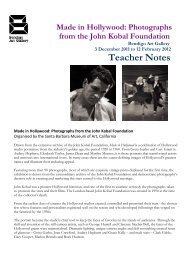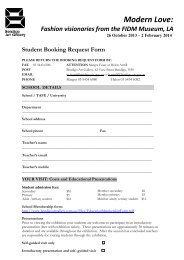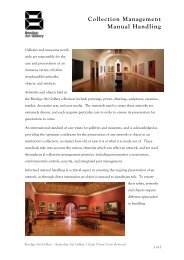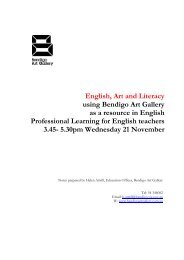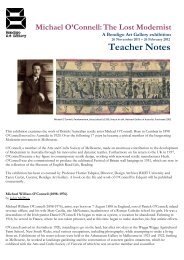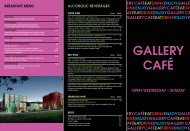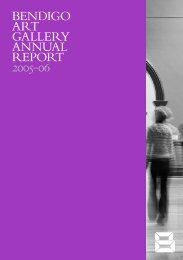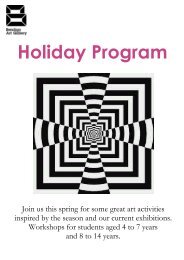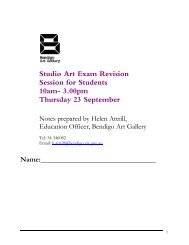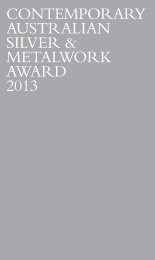ARCHITECTURAL DEVELOPMENTS - Bendigo Art Gallery
ARCHITECTURAL DEVELOPMENTS - Bendigo Art Gallery
ARCHITECTURAL DEVELOPMENTS - Bendigo Art Gallery
You also want an ePaper? Increase the reach of your titles
YUMPU automatically turns print PDFs into web optimized ePapers that Google loves.
<strong>ARCHITECTURAL</strong> <strong>DEVELOPMENTS</strong><br />
<strong>Bendigo</strong> is firmly positioned within Australian history as a major area of goldmining<br />
activity during the early 1850s. The city’s Victorian architecture, which remains<br />
imposing today, indicates the level of wealth and prosperity that this developing<br />
centre enjoyed in the late nineteenth century – the period during which <strong>Bendigo</strong> <strong>Art</strong><br />
<strong>Gallery</strong> was founded.<br />
In 1887 an association was formed for the purpose of promoting among the citizens of<br />
Sandhurst – as <strong>Bendigo</strong> was known until 1891 – a wider appreciation of artistic<br />
culture. The members of this body, encouraged by a groundswell of public interest<br />
and by the considerable success of the 1886–87 <strong>Bendigo</strong> Juvenile and Industrial<br />
Exhibition, promoted the idea that a picture gallery should be established within the<br />
town. In order to lay down a solid foundation for a new gallery, the citizens<br />
supporting this initiative sought donations, subscriptions, and subsidies from the<br />
colonial government in Melbourne.<br />
As a result of the combined energies of its various proponents, Sandhurst Fine <strong>Art</strong><br />
<strong>Gallery</strong> was established in July 1887 in a large hall at the <strong>Bendigo</strong> School of Mines,<br />
in McCrae Street. In 1890 the colonial government provided the new <strong>Gallery</strong> with<br />
more suitable premises, in View Street, initially at a rent equivalent to $2 per year in<br />
today’s currency. Erected in 1867, the building that had formerly housed the orderly<br />
room of the <strong>Bendigo</strong> Volunteer Riflemen had a distinctive polychromatic brick facade<br />
and a commanding presence in keeping with the <strong>Gallery</strong>’s role as an important civic<br />
institution.<br />
William Charles Vahland (1828–1915), the German-born architect who, in<br />
partnership with Robert Getzschmann (1824–1875), had designed the original<br />
building, was employed to convert it into a permanent home for the <strong>Gallery</strong>. Advice<br />
about the interior, appropriate hanging methods, and the ongoing selection of works<br />
for the fledgling collection was sought from the Director of the National <strong>Gallery</strong> of<br />
Victoria, George Frederick Folingsby. The display area within the new <strong>Bendigo</strong> <strong>Art</strong><br />
<strong>Gallery</strong> was aptly named Victoria Court, a reference to the founding of Sandhurst<br />
Fine <strong>Art</strong> <strong>Gallery</strong> in 1887, the year of Queen Victoria’s Golden Jubilee.<br />
The new <strong>Gallery</strong> premises were officially opened to the public by the colonial<br />
governor, Lord Hopetoun, on 14 October 1890. It soon became apparent, however,<br />
that more space was needed for the display of the rapidly expanding collection. A<br />
generous pledge of £50 from the government formed the basis of a building fund,<br />
which was then increased substantially by a £1443 bequest from local resident George<br />
Drury (1826–1890). Drury had arrived in Australia in 1854 from Kent in England,<br />
initially to try his luck as a gold prospector. By the time of his death in 1890 he was a<br />
wealthy and highly respected member of the Sandhurst community. When the <strong>Gallery</strong><br />
was extended in 1897, the new gallery space was given the name Drury Court, in<br />
recognition of George Drury’s great generosity.<br />
<strong>Bendigo</strong> <strong>Art</strong> <strong>Gallery</strong> 42 View Street <strong>Bendigo</strong> Victoria Australia 3550 Telephone 03 5434 6088 Facsimile 03 5443 6586<br />
Email bendigoartgallery@bendigo.vic.gov.au
By 1905 a third gallery, funded by public subscription (matched pound for pound by<br />
the Victorian Government), had been added. Alexandra Court, named for England’s<br />
new Queen, was designed by the leading <strong>Bendigo</strong> architect William Beebe (1857–<br />
1920) and opened to the public in August 1905, along with a refurbished Drury Court.<br />
Both galleries were designed in the grand European tradition, with polished kauri<br />
floors, ornate plaster arches and cornices, and diffused natural light admitted by<br />
ceiling skylights.<br />
Following nearly two decades of expansion and consolidation, the <strong>Gallery</strong> remained<br />
relatively unchanged until 1962, when a two-storey front wing was added, the project<br />
being funded by a Victorian Government grant and moneys from the estate of Louis<br />
Alfred Sonnenberg. L. A. Sonnenberg (1865–1947), a prominent local businessman,<br />
had bequeathed a portion of his estate to the <strong>Gallery</strong> for the purpose of funding<br />
extensions and renovations. A new interior space, made possible by the Sonnenberg<br />
Bequest, became part of the redesigned entrance, which led visitors through to the<br />
grandeur and elegance of the existing nineteenth-century rooms. Sonnenberg Court<br />
was opened in February 1962, together with another new display area, Neptune Scott<br />
Court, named after Dr James Andrew Neptune Scott (1868–1944) and his wife,<br />
Georgina. A more radical component of the 1962 redevelopment was the<br />
‘encapsulation’ of the original 1867 building, within a textured, salmon-coloured<br />
brick facade.<br />
Further changes occurred in the 1970s. In 1976 an east wing was added, its interior<br />
gallery taking the name Chamberlain Court, in memory of the parents of local resident<br />
Ivy Winifred Chamberlain. Meanwhile, the <strong>Gallery</strong> environs were themselves<br />
undergoing a transformation. An adjacent building, the Australian Natives’<br />
Association Hall (est. 1890), had been demolished and had been replaced by the ANA<br />
Motor Inn. In an era when grand theatres were being torn down, and petrol stations<br />
built in their stead, the <strong>Gallery</strong> was very much a part of the new streetscape.<br />
By the 1990s the <strong>Gallery</strong>’s interiors – with their hessian-covered walls and linoleumtiled<br />
floors – and the building’s 1960s facade, were looking decidedly dated. The lack<br />
of essential museum systems, such as climate and humidity controls and adequate<br />
security, was also becoming a matter of urgency.<br />
Until this time, the <strong>Gallery</strong> had been almost wholly supported by philanthropic<br />
bequests and government subsidies, but in 1995 it entered into an agreement with<br />
local government. Under the terms of the new relationship, the <strong>Gallery</strong>’s Board of<br />
Management undertook to retain responsibility for artistic matters, such as acquisition<br />
policies and the care and conservation of the art collection, while the City of Greater<br />
<strong>Bendigo</strong> assumed control of all operational functions.<br />
This arrangement made possible an ambitious redevelopment project, funded in large<br />
part by the City of Greater <strong>Bendigo</strong> and supported by a $1 million contribution from<br />
the Victorian Government. The redevelopment, with Karl Fender, of the Melbourne-<br />
<strong>Bendigo</strong> <strong>Art</strong> <strong>Gallery</strong> 42 View Street <strong>Bendigo</strong> Victoria Australia 3550 Telephone 03 5434 6088 Facsimile 03 5443 6586<br />
Email bendigoartgallery@bendigo.vic.gov.au
ased firm Nation Fender Katsalidis, appointed as architect, included the purchase<br />
and demolition of the ANA Motor Inn, the removal of the <strong>Gallery</strong>’s 1960s facade, the<br />
refurbishment of the nineteenth-century galleries, and the construction of new gallery<br />
spaces (including a Sculpture Annexe), shop, and administration area. Standard<br />
museum systems – a sophisticated lighting system, environmental controls for<br />
temperature and humidity, and state-of-the-art security – were also put in place for the<br />
first time, and storage facilities were upgraded. The <strong>Gallery</strong> launched this stage of its<br />
redevelopment in December 1998.<br />
August 2001 saw the opening of the Sidney Myer Work on Paper <strong>Gallery</strong> and the<br />
<strong>Gallery</strong> Cafe, both of which were funded primarily by The Sidney Myer Centenary<br />
Celebration 1899–1999, with additional support from the R H S Abbott Bequest<br />
Fund. The Sidney Myer Work on Paper <strong>Gallery</strong> is a dedicated space for the display of<br />
works on paper from the permanent collection, while also providing much-needed<br />
additional storage capacity and a new and fully equipped loading bay. The noted<br />
retailer and philanthropist Sidney Myer (1878–1934) established his first business in<br />
<strong>Bendigo</strong> more than one hundred years ago. In acknowledgement of his remarkable<br />
contribution to the community and the arts in Australia, the <strong>Gallery</strong> received moneys<br />
from the Sidney Myer Fund, and from the R. H. S. Abbott Bequest Fund, to<br />
commission artist Janet Laurence to create the Sidney Myer Commemorative<br />
Sculpture. The breath we share, 2002–03, was installed outside the <strong>Gallery</strong> Cafe in<br />
early 2003.<br />
Today, highlights from the <strong>Gallery</strong>’s collection of early Australian art are displayed in<br />
Bolton Court (formerly Victoria Court), while British and European works may be<br />
viewed in Abbott (formerly Alexandra) and Drury courts; nineteenth-century<br />
sculpture is presented in the Sculpture Annexe. The Sidney Myer Work on Paper<br />
<strong>Gallery</strong> is dedicated to the display of works on paper from the permanent collection,<br />
and smaller, temporary exhibitions of prints, drawings and photographs. A large space<br />
in the centre of the <strong>Gallery</strong> complex is used for temporary and touring exhibitions.<br />
The remaining galleries are given over to Australian art – paintings, sculpture and<br />
decorative arts – from the nineteenth, twentieth and twenty-first centuries.<br />
Karen Quinlan, Director<br />
Excerpt from Selected Works: <strong>Bendigo</strong> <strong>Art</strong> <strong>Gallery</strong><br />
<strong>Bendigo</strong> <strong>Art</strong> <strong>Gallery</strong> 42 View Street <strong>Bendigo</strong> Victoria Australia 3550 Telephone 03 5434 6088 Facsimile 03 5443 6586<br />
Email bendigoartgallery@bendigo.vic.gov.au



